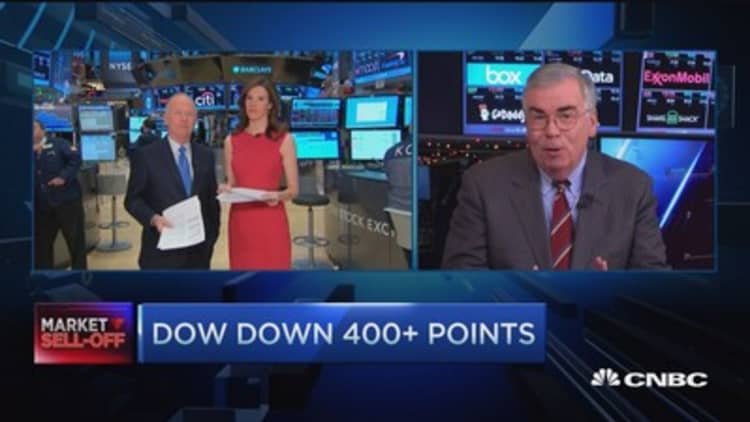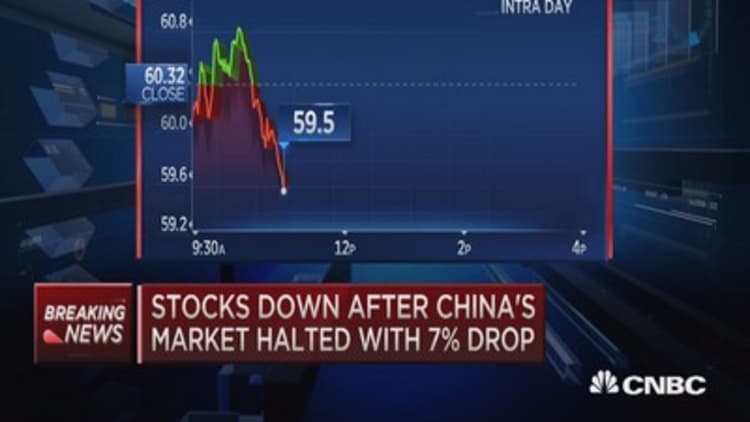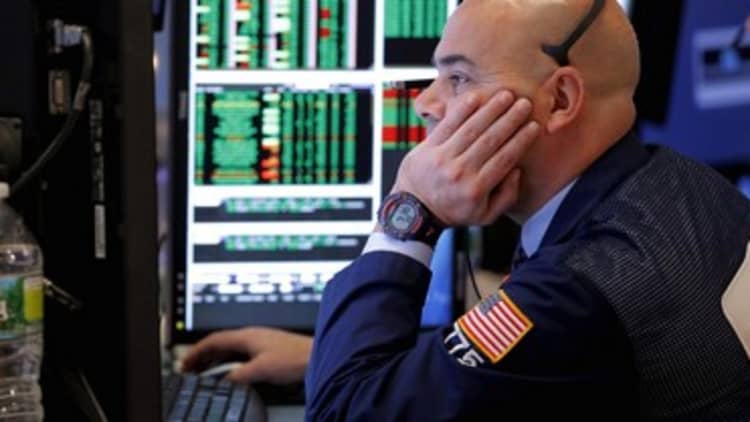



U.S. stocks closed lower Monday, the first day of trade of the year, weighed by renewed concerns of global economic slowdown and increased tensions in the Middle East. An overnight drop in Chinese stocks that triggered a circuit breaker under a new rule also pressured sentiment.
"Anytime a big market stops trading and it spills over to Europe, investors are nervous," said Marc Chaikin, CEO of Chaikin Analytics.
"Ex-China we were expecting a positive (market). At the end of the day, except for a few companies like Caterpillar, this really shouldn't have an impact on our markets," he said.
Caterpillar managed to eke out a slight gain on the day as one of the few advancing Dow components.
The major averages ended down more than 1.5 percent, recovering from session lows as the close approached. The Nasdaq composite underperformed with a decline of 2.08 percent after earlier falling more than 3 percent.
The S&P 500 and Nasdaq composite posted their worst start to the year since 2001.
The Dow Jones industrial average closed about 275 points lower. The index closed down 1.58 percent, for its worst start to the year since Jan. 2, 2008, when the Dow fell 1.66 percent. (Tweet This)
Earlier, the index fell 467 points, or more than 2.5 percent, temporarily on pace for its largest percent decline on the first trading day of the year since 1932.
"I guess it makes a little more difficult hole (at the) start of the year for the market to dig itself out of," said Daniel Deming, managing director at KKM Financial.
"This is just a culmination of some of the things built up over the weekend — conflict in the Middle East, lower highs and lower lows," he said.
In the close, the Dow held above the psychologically key 17,000 level after falling below in intraday trade for the first time since October.
"I think it's just some bottom fishing going on. Maybe some overreaction (earlier) to the news coming out of China. Oil still has a chance at a rebound," said Robert Pavlik, chief market strategist at Boston Private Wealth.
Leading the global decline in stocks Monday, Chinese stocks plunged after Caixin manufacturing PMI showed continued contraction in that area of the economy.
The Shanghai and Shenzhen exchanges ended the trading session early after the CSI 300 dropped 7 percent, triggering a circuit breaker. The halt was the first implementation of the new circuit breaker rule announced in September.
Read MoreChina's new circuit breaker may have worsened drop
U.S. data released Monday morning reaffirmed concerns about global manufacturing. The U.S. December ISM Manufacturing Index was 48.2, down from November's 48.6 print to its lowest since June 2009.
"That's not helping because last week we had a couple more minor PMI readings and they showed the same thing," said Mark Luschini, chief investment strategist at Janney Montgomery Scott.
Last Thursday, the Chicago PMI came in at 42.9 for December, down from 48.7 in November.
The S&P 500 closed about 1.5 percent lower, holding above the psychologically key 2,000 level. In intraday trade, the index fell more than 2.5 percent to fall below that level for the first time since mid-December.
"We took out 2,000 on the S&P 500 and 17,000 on the Dow. That (may be) creating some levels for some selling going down," Peter Coleman, head trader at Convergex, said of the mid-morning decline in stocks.
Financials closed down more than 2 percent to lead all S&P 500 sectors lower.
Read More Fed's Williams not too concerned over weak China data
The Nasdaq composite closed below the psychologically key 5,000 level for the first time since Dec. 21, 2015.
Apple eked out a gain of 0.09 percent after earlier falling more than 3 percent, while the iShares Nasdaq Biotechnology ETF (IBB) closed down about 3.4 percent.
Chinese e-commerce site JD.com fell nearly 8.5 percent and Tesla closed down almost 7 percent as the greatest decliners in the Nasdaq 100. Amazon was the third-greatest decliner, down 5.76 percent.
"A lot of it has to do with China and a lot of it is overdone," said Art Hogan, chief market strategist at Wunderlich Securities. "The China PMI hasn't changed much. It's not unusual to have an outsized reaction when you've got a base case that 2016 could be a tough year."
"I think it's very much global markets are in a risk-off mode. It's very hard to step in the way of (that)," he said.
European stocks closed sharply lower, with the German DAX falling more than 4 percent for its largest daily decline since Aug. 24, 2015. The STOXX Europe 600 closed about 2.5 percent lower.
Dow futures were down more than 300 points prior to the market open.
Read MoreMideast tensions adds to busy week for markets
Oil turned lower after initially rising amid increased tension in the Middle East.
U.S. crude oil futures settled down 28 cents, or 0.76 percent, at $36.76 a barrel, giving up an earlier spike to above $38.30 a barrel.
Saudi Arabia, the world's biggest oil exporter, cut diplomatic ties with Iran on Sunday in response to the storming of its embassy in Tehran. The protest followed Saudi Arabia's execution of a prominent Shiite cleric.
Read More Saudi Arabia vs Iran: The oil war that isn't coming
Asian stocks declined, with the Nikkei 225 falling 3.06 percent for its worst day since the end of September. China's Shanghai composite lost nearly 6.9 percent for its worst day since Aug. 25, 2015.
Traders also reduced positions in Chinese small caps ahead of the Friday expiration of a six-month selling ban imposed on the major shareholders of listed companies, StreetAccount said. The Chinese yuan also weakened to hit its lowest since 2011.
The iShares MSCI Emerging Markets ETF (EEM) closed down 2.73 percent. The Deutsche X-trackers Harvest CSI 300 China A-Shares ETF (ASHR) ended down 8.51 percent.
Over the weekend, China reported manufacturing PMI that remained below the 50 level that indicates contraction. The official manufacturing PMI for December was 49.7 after posting 49.6 in November, while the Caixin December manufacturing PMI was 48.2 versus November's 48.6.
The official services PMI edged higher to 54.4 from 53.6 the prior month.
Read MoreDon't expect a Netflix, Amazon repeat in 2016
In other U.S. economic news, the December U.S. Markit manufacturing PMI was 51.2.
Construction spending fell for the first time in nearly one-and-a-half years, down 0.4 percent in November.
The 10-year and 2-year Treasury yields touched their lowest levels in more than a week before edging higher. The held near 1.03 percent and the 10-year yield was around 2.24 percent in the close.
The U.S. dollar traded about 0.2 percent higher against major world currencies, with the euro near $1.08 and the yen at 119.40 yen against the greenback.
Gold futures for February delivery settled up $15 at $1,075.20 an ounce. The precious metal briefly hit $1,083, its highest in nearly a month.
Five-day performance
U.S. stocks closed lower Thursday, the last day of trade for 2015. Markets were closed Friday for New Year's Day.
The S&P 500 and Dow Jones industrial average posted losses for the year, their worst annual performance since 2008. The Russell 2000 and Dow transports also had their worst year in seven.
The Nasdaq composite ended more than 5.5 percent higher for 2015, helped by outperformance in biotech stocks and major tech names, except Apple. The iPhone maker's stock turned in its first negative year since 2008.
Major U.S. Indexes
On Monday, the Dow Jones industrial average closed down 276.09 points, or 1.58 percent, to 17,148.94, with DuPont leading decliners. Wal-Mart, Apple and Caterpillar were the only components that ended higher.
The closed down 31.28 points, or 1.53 percent, at 2,012.66, with financials leading all 10 sectors lower.
The Nasdaq composite closed down 104.32 points, or 2.08 percent, at 4,903.09.
The Dow transports closed down 2.08 percent.
The CBOE Volatility Index (VIX), widely considered the best gauge of fear in the market, held near 20.7 after earlier topping 23 to hit its highest level in two weeks.
About two stocks declined for every advancer on the New York Stock Exchange, with an exchange volume of 1.1 billion and a composite volume of 4.3 billion.
U.S. trade volume across all exchanges was the highest in two weeks.
Read MoreEarly movers: MCD, EMC, NFLX, CMG, LULU, TSLA, LVS, NOK, P & more
On tap this week:
Monday
5:30 p.m.: San Francisco Fed President John Williams speaks on the implementation of macroprudential policies by central banks at the AEA Annual Meeting in California.
Tuesday
Earnings: Eli Lilly (2016 guidance only), Sonic
December light vehicle sales announced
Wednesday
Earnings: Monsanto, RPM International
7 a.m.: Mortgage applications
8:15 a.m.: ADP employment report
8:30 a.m.: International trade
9:45 a.m.: PMI services index
10 a.m.: Factory orders and ISM non-manufacturing index
10:30 a.m.: Oil inventories
2 p.m.: FOMC minutes
Thursday
Earnings: Walgreens Boots Alliance, Constellation Brands, Finish Line, KB Home, Bed Bath & Beyond, PriceSmart, Ruby Tuesday, Synnex, The Container Store, WD-40
7:30 a.m.: Challenger job-cut report
8:45 a.m.: Richmond Fed President Jeffrey Lacker speaks on the economic outlook for January 2016 at the Greater Raleigh Chamber of Commerce in Raleigh, North Carolina.
8:30 a.m.: Jobless claims
10:30 a.m.: Natural gas inventories
2:15 p.m.: Chicago Fed President Charles Evans speaks on economic conditions and monetary policy at the Wisconsin Economic Forecast Luncheon in Madison, Wisconsin.
4:30 p.m.: Fed balance sheet/money supply
Friday
Earnings: Acuity Brands
8:30 a.m.: Non-farm payroll, unemployment rate and average hourly wages
10 a.m.: Wholesale trade
1 p.m.: Rig count
3 p.m.: Consumer credit and Treasury STRIPS
*Planner subject to change.
More From CNBC.com:






